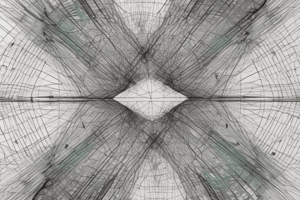Podcast
Questions and Answers
What mathematical object is at the core of Linear Algebra?
What mathematical object is at the core of Linear Algebra?
- Decimals
- Irrational Numbers
- Fractions
- Vectors (correct)
In Linear Algebra, what structures can be constructed using two operations?
In Linear Algebra, what structures can be constructed using two operations?
- Planes and Lines
- Matrices and Equations
- Fields and Rings
- Vector Spaces and Linear Transformations (correct)
Which of the following is NOT typically studied in Linear Algebra?
Which of the following is NOT typically studied in Linear Algebra?
- Equation Systems
- Matrices
- Linear Manifolds
- Irrational Numbers (correct)
What kind of sets play a crucial role in Linear Algebra?
What kind of sets play a crucial role in Linear Algebra?
Which mathematical structure represents a collection of vectors?
Which mathematical structure represents a collection of vectors?
In Linear Algebra, what do we use to represent relationships between linear equations?
In Linear Algebra, what do we use to represent relationships between linear equations?
Which symbol is used to represent a vector in mathematics?
Which symbol is used to represent a vector in mathematics?
In set theory, what does the symbol '∀' signify?
In set theory, what does the symbol '∀' signify?
What does the symbol '⇒' represent in mathematical logic?
What does the symbol '⇒' represent in mathematical logic?
Which set includes natural numbers, counting numbers, integers, positive integers, negative integers, and rational numbers?
Which set includes natural numbers, counting numbers, integers, positive integers, negative integers, and rational numbers?
Which of the following represents the Cartesian product of sets A and B?
Which of the following represents the Cartesian product of sets A and B?
What does the symbol '!' represent in mathematical notation?
What does the symbol '!' represent in mathematical notation?
Which of the following is true about the equality of two vectors?
Which of the following is true about the equality of two vectors?
What is the purpose of the transpose operator $\mathbf{x}^T$ mentioned in the text?
What is the purpose of the transpose operator $\mathbf{x}^T$ mentioned in the text?
What is the special vector $\mathbf{0} \in \mathbb{R}^n$ associated with in the text?
What is the special vector $\mathbf{0} \in \mathbb{R}^n$ associated with in the text?
Which of the following comparison operators are not defined for vectors according to the text?
Which of the following comparison operators are not defined for vectors according to the text?
What is the assumption made about the vectors in the lectures according to the text?
What is the assumption made about the vectors in the lectures according to the text?
Flashcards are hidden until you start studying
Study Notes
Linear Algebra Fundamentals
- The mathematical object at the core of Linear Algebra is the vector.
- Using two operations (addition and scalar multiplication), vector spaces and matrices can be constructed.
- Calculus is not typically studied in Linear Algebra.
Vector Sets and Notation
- Vector sets, such as Euclidean spaces, play a crucial role in Linear Algebra.
- A vector space represents a collection of vectors.
- Vectors are represented using boldface letters (e.g., x) or an arrow above the letter (e.g., →x).
- The symbol '∀' in set theory signifies "for all".
- The symbol '⇒' in mathematical logic represents implication.
Set Operations and Notation
- The set of real numbers includes natural numbers, counting numbers, integers, positive integers, negative integers, and rational numbers.
- The Cartesian product of sets A and B is represented as A × B.
- The symbol '!' in mathematical notation represents the factorial operation.
Vector Operations and Properties
- Two vectors are equal if and only if their corresponding components are equal.
- The transpose operator $\mathbf{x}^T$ is used to transform a column vector into a row vector.
- The special vector $\mathbf{0} \in \mathbb{R}^n$ is associated with the zero vector.
- The comparison operators <, >, ≤, and ≥ are not defined for vectors.
- In the lectures, it is assumed that vectors are from the Euclidean space $\mathbb{R}^n$.
Studying That Suits You
Use AI to generate personalized quizzes and flashcards to suit your learning preferences.





